#animal testing questions alternatives & analyses
Photo

Legally Blonde 2: Red, White & Blonde (2003) by Charles Herman-Wurmfeld
Book title
Animal Liberation (1975) by Peter Singer
Living in Harmony with Animals (2000) by Carla Bennett
Constitution, Jefferson’s Manual, and the Rules of the House of Representatives
Food Drug and Cosmetic Act: A Practical Guide to Law & Regulation
Animal Testing Question: Alternatives & Analyses
History of the FDA
#legally blonde 2 red white & blonde#charles herman-wurmfeld#books in movies#animal liberation#peter singer#living in harmony with animals#carla bennett#constitution jefferson's manual and the rules of the house of representatives#food drug and cosmetic act a practical guide to law & regulation#animal testing questions alternatives & analyses#history of the fda
50 notes
·
View notes
Link
Opinion: Mandated Vaccinations — Who is responsible for their risks?
by Heidi Wetzler
Clark County Today Administrator Heidi Wetzler shares her thoughts on the repercussions of COVID-19 vaccine mandates
“If I am mandated to receive a COVID-19 vaccine in order to keep my job, and subsequently experience an adverse event, who is responsible? Who is responsible if I have neurological complications, a heart attack, or a stroke and am never able to work again. Who is responsible if I die?
Correct me if I’m wrong, but I’ve read that neither the vaccine companies, the government entities imposing the mandates, nor the employers themselves will be held responsible in any way if the worst happens. In fact, from what I’ve seen and read so far, it will take a Herculean effort to prove that my adverse reaction was caused by the vaccine. Correlation does not equal causation, they say. But when you are counted as a COVID-19 death, correlation ALWAYS equals causation.
Recently there was a lawsuit filed against the federal government accusing the government of covering up the fact that 45,000 people have died within the first three days of receiving a COVID-19 vaccine. There are over 13,000 deaths reported to VAERS (vaccine adverse event reporting system) on the CDC website. This number is widely believed to include only 1-10 percent of the actual deaths that have occurred. And then there are hundreds of thousands of transient to severe reactions reported to VAERS. That being said, I can easily find article after article debunking the accuracy of these statistics. Anyone can report anything in the VAERS system, they say, so obviously it is not going to be perfect. But it is the ONLY avenue people have to account for their experiences. A line item on a discounted reporting system is the ONLY recourse one has when they believe they’ve lost their loved one to this “safe and effective” vaccine.
If the validity of every single one of these adverse events is going to be questioned, then can someone please direct me to the “verified” information? Where can I find the non-refuted deaths, heart attacks, blood clots, and neurological problems that HAVE been associated with the vaccine? You can’t expect the general public to believe there are zero. So where is the data? In my mind, for each doctor, government official, and layperson to claim that these vaccines are safe, the risk of death needs to be zero. The risk of an adverse event needs to be zero. If that is not the truth, then the truth needs to be spelled out in black and white. Where is it? Informed consent. Where is it?
I’ve heard the following argument for getting the vaccination a nauseating amount of times. The argument is that the deaths and risks from the vaccine pale in comparison to the deaths from COVID-19. If you knew ahead of time that you or your child were going to die from this vaccine would your heart be comforted by the fact that “so many more people died from the virus?” This debate is illogical on a personal level. This is a decision that should be based on each and every one of our own personal risk and benefit analyses. Speaking of children, in the 2017-2018 flu season 643 children died. To date, 332 children have died from COVID-19. Mass vaccinating children with an experimental product, who are at little-to-no risk of harm from this virus, is in my opinion, grossly negligent.
There is now compelling evidence that the vaccinated spread the virus with the same viral load as the unvaccinated. So what the heck does it matter if I get the vaccine or not, if it is not protecting the people around me at all. The argument that the vaccinated are protecting the unvaccinated is moot. Why are the same ineffective vaccines still being pushed? And now there is talk of boosters. Government contracts perhaps.
Another argument is that the unvaccinated are getting sick more often and taking up hospital bed space. I’ve heard the opposite as well. The truth is elusive. To this I say, 78 percent of those who have been hospitalized with COVID-19 are overweight or obese. As many as 95 percent of those who die are obese. So before we blame the unvaccinated for hogging up all of the hospital bed space, let’s first blame the obese. But that’s not appropriate to mention. It’s much more acceptable to call those that are concerned about the side effects of the vaccine, selfish and deserving of death. Additionally, 80 percent of those that get COVID-19 have low Vitamin D levels in their body. How about we focus on this metric and see if we can drastically reduce the number of those that are becoming ill? But there’s no money to be made on Vitamin D.
I have watched countless videos, and read many more stories from health care professionals as well as individuals who believe these vaccines are causing grave harm. And this is only in the first year. Many more virologists, doctors and scientists purport that the majority of the deaths are still to come due to clotting, antibody dependent enhancement and a general weakening of the immune system. And the coming boosters will increase these risks. This information continues to be censored and suppressed. I’ve written in this space before about the global suppression of early treatment options and how 85 percent of those who have died from COVID-19, died needlessly without the aid of effective early treatment.
And why in the world are we not talking about natural immunity? Testing for natural immunity? Accepting it as an alternative to the vaccine? Natural immunity is robust and durable. They say “we don’t know how long it lasts.” Well then I hope they are testing vigorously to find out. We already know the vaccine is failing before natural immunity. Conservatively, 100 million Americans have been exposed to this virus and are therefore immune. Those who had SARS-CoV-1 in 2002-2003 were still immune 17 years later, and those who survived the influenza pandemic of 1918 were still immune to the H1N1 outbreak in 2009-2010 a stunning 92 years later. Why is this conversation non existent? Especially when we are at a crossroads between those who are willing to get the vaccine and those who aren’t. My family has already had the virus and under normal circumstances, the medical community would agree that we are now most likely immune. For some reason natural immunity through infection is all of a sudden questioned.
You aren’t being forced to get the vaccine, they say. You just can’t have a job they say. Well if that’s not medical coercion, then please tell me what is. Most people need to make money to eat.
Lastly, there is the issue of variants. Variants of viruses with animal reservoirs such as COVID-19 will exist until the end of time. They will never go away. I’ve read that vaccinating during the height of a pandemic causes stronger variants. The virus has not had a chance to weaken, which normally takes 2-3 years. The vaccine is applying non lethal pressure to the virus, which is encouraging the creation of stronger variants. This could help to explain why we have a nation with a fairly high vaccination rate, dealing with a strong variant.
If my choice to not get vaccinated, ends up with me dying from COVID-19, then that has been my choice. That should remain my choice. No one needs to protect me from myself. In all honesty, I am terrified of the vaccine. Just as many are terrified of COVID-19. We need to demand the adverse event statistics they are gathering and refusing to release. This is a continuing trial period, so you know they are tracking everything and have copious data. People are hesitant because calling it completely safe is irresponsible and untrue. The suppression of known risks is nothing less than malfeasance from our government and medical professionals. We won’t know the gravity of this experiment for 10 years or more.
As long as 480,000 Americans die from tobacco-related illnesses each year, and we still have tobacco products on the store shelves, you will never convince me that the government cares about my health. Which is fine by me. That’s freedom. This is about power and control that they never want to relinquish and it will take every single one of our voices to overcome that.”
1 note
·
View note
Text
VOCOCENTRISM
as the name suggests, vococentrism prioritises the dialogue, of a scene: over the other aspects (Sound Effects, Music, etc.)
for the most part, stating that the majority of films are vococentric - would be true, as directors carefully design the dialogue between characters to best convey the story, to the viewer.
however, there are a selective minority of media - that manage to break this convention: and i want to make this post to briefly address the strengths and weaknesses of a very famous example of this:

“Mr Bean” (January 1st 1990 - December 15th 1995)
despite being a British cult-classic: the original series, was short lived with only 15 (24-26 minute) episodes.
the series, starred Rowan Atkinson as a a strange, mute humanoid named: “Mr Bean” who used his unusual (albeit: entertaining) wit to fulfil everyday tasks. But more often than not, his childish antics end up creating trouble for himself and those around him...
the series thrived, with an animated spinoff: and multiple movies.

I think the strengths of the series all relate back to Atkinson’s portrayal of Bean.
Atkinson has a talent, most inherently shown through his portrayal of Bean, of being able to manipulate his face in humorous ways to convey exaggerated emotion, in the place of dialogue: much like earlier silent films, that relied on the use of music and movement to enhance the scenes.
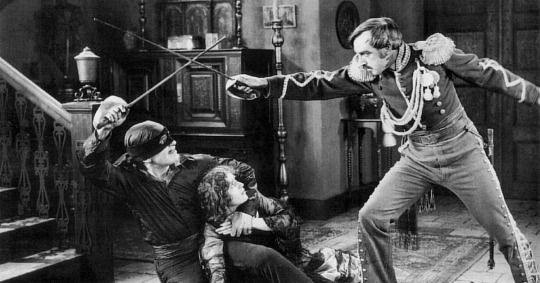
exaggerated acting is a common theme of pantomimes, and other media that appeals mostly to children: as the obvious, “in your face” way of expressing emotion is a simple way to convey this to a simple-minded audience, without them having to analyse subtle things.
Atkinson’s approach is by no means revolutionary: in fact, it’s rather simple - but that's the point.
it’s appealing to children.
Mr Bean never has anything close to a normal interaction with anyone he meets - due to his limited speech, which throughout the series is used as a tool to further escalate the ridiculous situations the character finds himself in, as something that could be explained and talked through, is instead being driven further by his muttering and stammering.
in place of dialogue, Bean relies on much more physical acting; from not only himself, but the people he interacts with. this is further enhanced through the use of a laugh track, to remind the audience that the very vaudeville tone is due to the fact they’re trying to make you laugh, as this is a comedic show.
What's more, he always wears the same clothes, a common trope with characters, especially in cartoons and other children’s media: as they remain in one outfit: to keep an iconic look.

At the beginning of each episode, you see a bright light appear on the ground, it grows bigger and bigger until it stops and Mr Bean falls, which is interpreted as a comical take being beamed down from an alien spaceship.
despite being a comedic show: and Bean is strange to further this, i like to imagine that he used to be normal, which is how he has his own apartment, a girlfriend, and money. But then he was abducted by aliens, tested on, and dumped back onto Earth - with no memory of anything but his name, with it being one of the only lines he has throughout the show’s original run - in turn creating this unusual character, who doesn't know how to interact with people.
Bean’s many strengths lay within the shows reliance on not speech, but physical comedy: however, this is also the show’s downfall.
dialogue provides the opportunity for characters in world to ask appropriate questions, that the viewer may also be thinking - to expand upon the viewer’s knowledge of the world they live in.
dialogue allows characters to express more depth, articulating problems and issues, imagining life's many possibilities, seeing where things lead, evaluate alternatives - without this they have a distinct disadvantage of engaging with not only the audience, but others in their world.
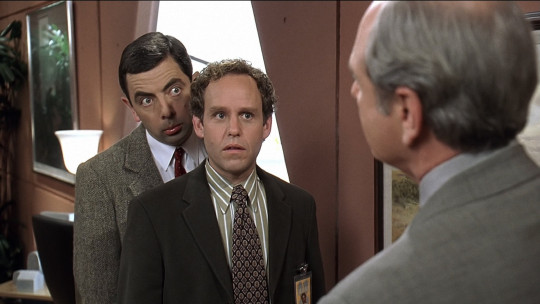
Mr Bean is a charming show.
Bean as a character is interesting, while also being humorous.
in later instalments in the franchise - there is a shift in tone, with movies being a longer media than half hour episodes that featured multiple storylines, the films followed a set journey about Bean travelling to unfamiliar places (the USA, and a holiday to France.) where he has interact with people.
here, there is a much heavier reliance on dialogue to not just extend the scenes, for run-time: but also provide more depth: to justify a longer production.
with these films, the focus shifts more towards the characters bean interacts with.
- the family he stays with in the USA - Bean’s interference on their lives puts stress on a constantly worrying father, but ultimately his mannerisms result in the two becoming good friends.
- he helps his moody teenage daughter, open up more.
- Sabine, and Stephan - an amateur actress, and a child who got separated from his father on a train: both interact with Bean, and him traveling with them aids them in their individual goals,

Bean remains a constant - his character already developed as far as he’s capable to. instead his use is comic relief, while the rest of the characters on stage witness his hijnix and progress the story.
this could not have been done, if the format didn't change
dialogue driven media is arguably a much more effective way at giving a viewer a more fulfilling experience.
media like Bean are an effective way of conveying short, simple storylines: fit for multiple sketches across a half-hour Tv-show. but for most other media, I’d argue that being dialogue reliant is not a weakness, but a way to allow for better storytelling.
the use of dialogue allows further acting, further world-building - there is just more sustenance to it all.
dialogue is not necessary to provide the viewer with the information they need to engage in the story, but it is a clear and concise method to deliver more, in an effective and enjoyable way.
anyway, that’s my thoughts on it at least.
1 note
·
View note
Photo

The guardian angel of Science and Tech
https://www.linkedin.cn/feed/update/urn:li:activity:6748246588021452800
We are living in a technical age. Many are convinced that science and
technology hold the answers to all our problems. We should just let the
scientists and technicians go on with their work, and they will create
heaven here on earth. But science is not an enterprise that takes place on
some superior moral or spiritual plane above the rest of human activity.
Like all other parts of our culture, it is shaped by economic, political and
religious interests.
Science is a very expensive affair. A biologist seeking to understand
the human immune system requires laboratories, test tubes, chemicals
and electron microscopes, not to mention lab assistants, electricians,
plumbers and cleaners. An economist seeking to model credit markets
must buy computers, set up giant databanks and develop complicated
data-processing programs. An archaeologist who wishes to understand
the behavior of archaic hunter-gatherers must travel to distant lands,
excavate ancient ruins and date fossilized bones and artefacts. All of this
costs money.
During the past 500 years’ modern science has achieved wonders
thanks largely to the willingness of governments, businesses, foundations
and private donors to channel billions of dollars into scientific research.
These billions have done much more to chart the universe, map the
planet and catalogue the animal kingdom than did Galileo Galilei,
Christopher Columbus and Charles Darwin. If these particular geniuses
had never been born, their insights would probably have occurred to
others. But if the proper funding were unavailable, no intellectual
brilliance could have compensated for that. If Darwin had never been
born, for example, we’d today attribute the theory of evolution to Alfred
Russel Wallace, who came up with the idea of evolution via natural
selection independently of Darwin and just a few years later. But if the
European powers had not financed geographical, zoological and
botanical research around the world, neither Darwin nor Wallace would
have had the necessary empirical data to develop the theory of
evolution. It is likely that they would not even have tried.
Why did the billions start flowing from government and business
coffers into labs and universities? In academic circles, many are naïve
enough to believe in pure science. They believe that government and
business altruistically give them money to pursue whatever research
projects strike their fancy. But this hardly describes the realities of
science funding.
Most scientific studies are funded because somebody believes they can
help attain some political, economic or religious goal. For example, in
the sixteenth century, kings and bankers channelled enormous resources
to finance geographical expeditions around the world but not a penny
for studying child psychology. This is because kings and bankers
surmised that the discovery of new geographical knowledge would
enable them to conquer new lands and set up trade empires, whereas
they couldn’t see any profit in understanding child psychology.
In the 1940s the governments of America and the Soviet Union
channelled enormous resources to the study of nuclear physics rather
than underwater archaeology. They surmised that studying nuclear
physics would enable them to develop nuclear weapons, whereas
underwater archaeology was unlikely to help win wars. Scientists
themselves are not always aware of the political, economic and religious
interests that control the flow of money; many scientists do, in fact, act
out of pure intellectual curiosity. However, only rarely do scientists
dictate the scientific agenda.
Even if we wanted to finance pure science unaffected by political,
economic or religious interests, it would probably be impossible. Our
resources are limited, after all. Ask a congressman to allocate an
additional million dollars to the National Science Foundation for basic
research, and he’ll justifiably ask whether that money wouldn’t be better
used to fund teacher training or to give a needed tax break to a troubled
factory in his district. To channel limited resources we must answer
questions such as ‘What is more important?’ and ‘What is good?’ And
these are not scientific questions. Science can explain what exists in the
world, how things work, and what might be in the future. By definition,
it has no pretensions to knowing what should be in the future. Only
religions and ideologies seek to answer such questions.
Consider the following quandary: two biologists from the same
department, possessing the same professional skills, have both applied
for a million-dollar grant to finance their current research projects.
Professor Slughorn wants to study a disease that infects the udders of
cows, causing a 10 per cent decrease in their milk production. Professor
Sprout wants to study whether cows suffer mentally when they are
separated from their calves. Assuming that the amount of money is
limited, and that it is impossible to finance both research projects, which
one should be funded?
There is no scientific answer to this question. There are only political,
economic and religious answers. In today’s world, it is obvious that
Slughorn has a better chance of getting the money. Not because udder
diseases are scientifically more interesting than bovine mentality, but
because the dairy industry, which stands to benefit from the research,
has more political and economic clout than the animal-rights lobby.
Perhaps in a strict Hindu society, where cows are sacred, or in a
society committed to animal rights, Professor Sprout would have a better
shot. But as long as she lives in a society that values the commercial
potential of milk and the health of its human citizens over the feelings of
cows, she’d best write up her research proposal so as to appeal to those
assumptions. For example, she might write that ‘Depression leads to a
decrease in milk production. If we understand the mental world of dairy
cows, we could develop psychiatric medication that will improve their
mood, thus raising milk production by up to 10 per cent. I estimate that
there is a global annual market of $250 million for bovine psychiatric
medications.’
Science is unable to set its own priorities. It is also incapable of
determining what to do with its discoveries. For example, from a purely
scientific viewpoint it is unclear what we should do with our increasing
understanding of genetics. Should we use this knowledge to cure cancer,
to create a race of genetically engineered supermen, or to engineer dairy
cows with super-sized udders? It is obvious that a liberal government, a
Communist government, a Nazi government and a capitalist business
corporation would use the very same scientific discovery for completely
different purposes, and there is no scientific reason to prefer one usage
over others.
In short, scientific research can flourish only in alliance with some
religion or ideology. The ideology justifies the costs of the research. In
exchange, the ideology influences the scientific agenda and determines
what to do with the discoveries. Hence in order to comprehend how
humankind has reached Alamogordo and the moon – rather than any
number of alternative destinations – it is not enough to survey the
achievements of physicists, biologists and sociologists. We have to take
into account the ideological, political and economic forces that shaped
physics, biology and sociology, pushing them in certain directions while
neglecting others.
Two forces in particular deserve our attention: imperialism and
capitalism. The feedback loop between science, empire and capital has
arguably been history’s chief engine for the past 500 years. The
following chapters analyse its workings. First we’ll look at how the twin
turbines of science and empire were latched to one another, and then
learn how both were hitched up to the money pump of capitalism. #money #science #technology #innovation #tech # # # #like #travel #tech #data #technology #innovation #ai #artificialintelligence #india #deeplearning #culture #work #markets #research #datascience #machinelearning #globalgiving #nonprofit
1 note
·
View note
Text
1. Un projet personnel et professionnel
a. Qui suis-je ? Je me présente
Je m’appelle Lou Ana Girard, j’ai 20 ans. Je suis actuellement en master grande école en 1 ère année. J’ai obtenu un bac littéraire au lycée Louis Feuillade à Lunel (34). Après mon bac, je suis partie en BTS MUC (management des unités commerciales) au lycée Saint Stanislas à Carcassonne (11). J’ai intégré l’ESC Clermont Business School en 2019.

b. Mes qualités personnelles
Je suis une personne qui s’adapte très vite aux situations. Je suis quelqu’un de déterminée, quand je veux quelque chose je mets tout en œuvre afin de pouvoir réaliser mon objectif. Mes différentes expériences font de moi une personne qui aime le travail en équipe et qui est force de proposition.

C. Traits de caractère : 3 points forts, 3 points à améliorer
Points forts :
- Déterminé comme je l’ai dit plus haut je me donne les moyens de réussir et je sais ce que je veux.
- Esprit d’équipe grâce à mes différentes expériences j’ai appris l’importance du travail en équipe.
- Autonome je sais analyser les situations et prendre des décisions afin de les améliorer.
Points faibles :
- Impatiente j’aime que les choses soient vite et bien faîtes. J’ai du mal à comprendre pourquoi les personnes peuvent être aussi longue dans certaine situation.
- Franche j’aime que les gens soient transparents avec moi, comme je le suis avec eux. Ça m’est déjà arrivé de blesser une personne en lui disant ce qui n’était pas bien. Il faut que j’apprenne à le dire de manière plus diplomate.
- Opiniâtre quand j’ai une idée en tête je ferai tout pour la réaliser et il faut argumenter pour me montrer que j’ai tort.
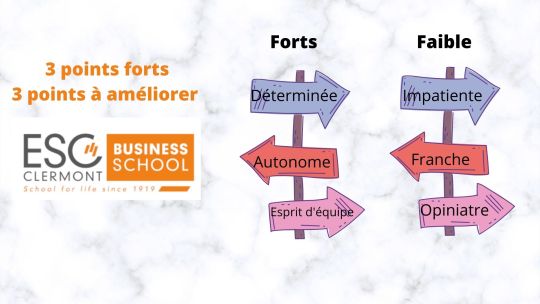
D. Mes valeurs
Pour expliquer mes valeurs, j’ai choisi de les exprimer à travers des citations :
- Tout seul on va plus vite, ensemble on va plus loin.
A travers mes expériences et ma formation j’ai compris qu’être ensemble était une force qu’il faut exploiter. C’est important de pouvoir discuter et confronter nos idées afin que le rendu final puisse être le plus pertinent possible. On vient tous d’un milieu différent et on a tous des pensées différentes c’est pour cela qu’ensemble on est plus pertinent.
- Pas de rêve que des objectifs.
Comme je l’ai dit plus haut, ma détermination est ma force, lorsque je veux quelque chose je n’attends pas que cela tombe du ciel, je me donne les moyens de réussir.
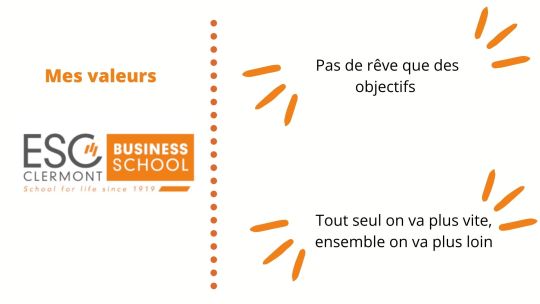
e. Ce qui me motive dans la vie : mes appétences et mes centres d’intérêts
J’aime le sport, j’ai fait du Krav maga pendant 2 ans cela m’a appris à forger mon caractère et ne jamais rien lâcher. Pendant mes études j’ai dû arrêter le Krav maga, cependant j’ai continué le sport avec de la course à pied et du fitness.
Cela me permet d’évacuer mon stress, me défouler et de pouvoir me concentrer sur ce que je fais.
Je suis aussi très intéressée par la cuisine, cet univers me rappels les différents voyages que j’ai pu faire à travers le monde. C’est une ouverture d’esprit pour moi que de comprendre leurs mélanges et leurs origines culinaires.
La cuisine est pour moi un moyen de mieux comprendre mon corps car l’alimentation est très importante pour notre santé.
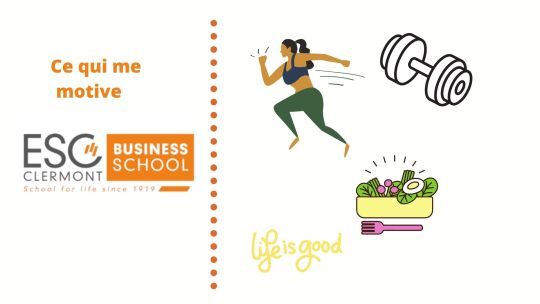
1. Que savais-je faire avant d’intégrer le programme ?
a. Quelles étaient mes compétences formelles ?
- M’exprimer à l’oral
- M’exprimer à l’écrit (mail, courrier, … )
- Réaliser des plannings
- Vendre (étapes de la vente)
- Gérer des conflits
- Réalisation de tableau de bord
- Établir un bilan d’opération commerciale
- Utiliser des outils informatiques
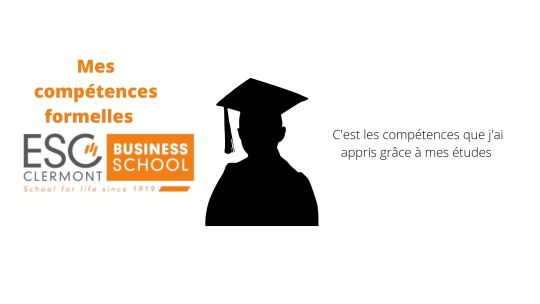
b. Quelles sont mes compétences informelles ?
- Écoute (je suis capable de prendre en compte ce qu’on me dit. Je sais reconnaître les besoins du personnel et des clients)
- Adaptation (grâce à mes expériences je sais m’adapter à tous les types de situation).
- Rigueur (j’ai le souci de bien faire, je suis très pointilleuse lorsque je réalise des tâches).
- Ponctuelle (je déteste arriver en retard)
- Organisation (je suis une personne très organisée et j’aime contrôler les choses).
- Curiosité (j’aime apprendre et connaître des nouvelles choses)
- Persévérance (lorsque je veux quelque chose je fais tout pour l’obtenir)
- Réactivité (j’analyse les situations et je prends des décisions rapidement afin de gérer une situation)
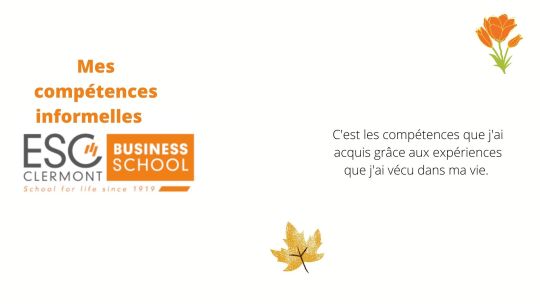
c. Stages en entreprise avant ma formation
J’ai réalisé un stage de 2 ans chez Orchestra Saint Aunes (34). Ce stage m’a vraiment permis de découvrir le commerce. En effet c’était le magasin du siège. On était donc un magasin test. Durant ces deux ans, j’ai pu voir la mise en place de nouveaux services : carte de fidélité payante avec différents essais sur le prix. Nous avons aussi pour lutter contre la concurrence mis en place une boxe de livraison de couche à domicile où en magasin.
J’ai réalisé aussi le métier de vendeuse : préparation des soldes, merchandising, conseil client, rangement, réception de commande, gestion de crise avec le client, période de noël, mise en place d’une opération commerciale.
Pour mon stage, j’ai aussi organisé un défilé pour présenter la collection printemps/été 2019. J’ai dû gérer : la communication, la sélection des articles, la sélection des mannequins, les invitations, le mailling, l’évènement.
Ce stage grâce à ma tutrice ma vraiment permis d’ouvrir les yeux sur le commerce et de mieux l’appréhender. C’est ce qui m’a poussé à continuer mes études dans ce secteur.
J’ai aussi des expériences en centre de lorisir, chez McDonnald’s, Leroy Merlin.
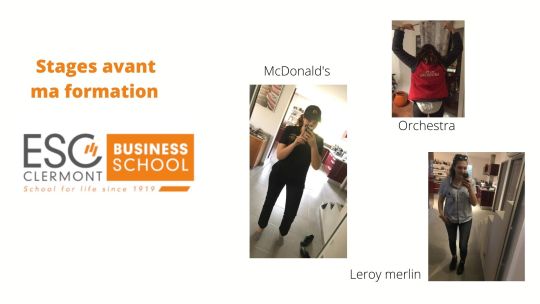
d. Projets menés en dehors de ma formation
J’ai passé mon BAFA, c’est un diplôme que j’ai souhaité passer afin de pouvoir travailler en centre de loisir. Je me suis spécialisée dans l’handicaps chez les petits de maternels. J’ai passé mon BAFA à 17 ans.
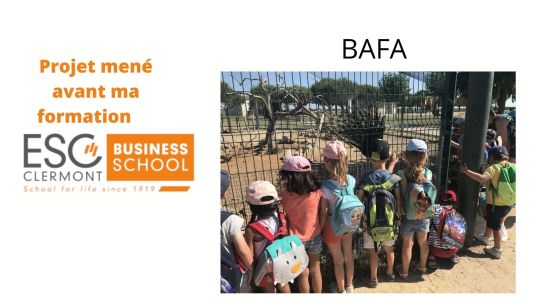
1. Ma formation actuelle
a. Les objectifs pédagogiques de ma formation :
En faisant une école de commerce je souhaitais pouvoir intégrer des associations afin de pouvoir développer d’autre compétences.
Je souhaite aussi avoir un niveau d’étude plus élevé avec des compétences concrètes afin de pouvoir espérer avoir des postes à responsabilité.
L’école de commerce est pour moi un tremplin afin de pouvoir me lancer pleinement dans la vie professionnelle en développent mon réseau et mes compétences.
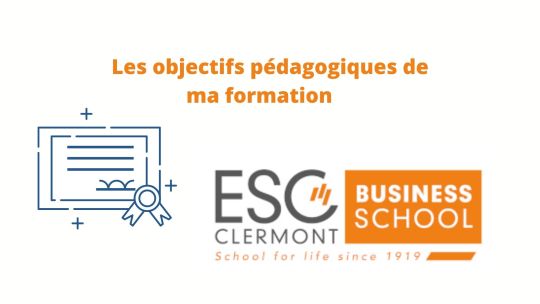
b. Mes objectifs :
Quel est l’axe sur lequel j’ai :
Le moins progressé
- Les langues
Le plus progressé
- Le travail d’équipe
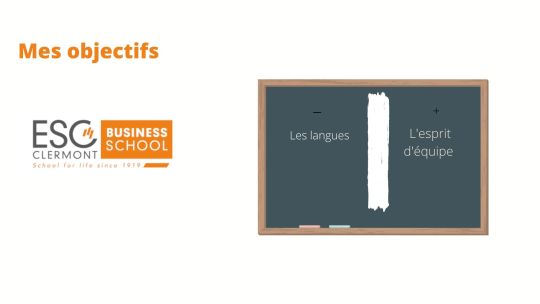
Quelles sont les compétences sur lesquelles je dois encore progresser ?
Je dois vraiment progresser sur les langues étrangères : l’anglais et l’espagnol.
Comment vais-je procéder ?
Sachant que je souhaite faire de l’alternance, je souhaite progresser en prenant des cours d’anglais à l’extérieur de l’école et en essayant d’oser plus discuter avec les étrangers qui viennent dans notre école.
Parmi les objectifs que je m’étais fixés en rentrant à l’ESC Clermont, quels sont ceux qui sont :
Atteints
Intégrer des associations (SEGMA et GO2C)
Trouver une alternance (Directeur de magasin chez LIDL)
Aisance orale
Animation de réunion
Non atteints
Parler Anglais
Faire mon stage à l’étranger
Être dans la classe 100% anglais
c. Mes compétences (MGE1, MGE2, Césure)
· Au début de la formation
- Marketing
- Mise en place d’un événement
· A la fin de la 1ère année de formation (2018-2019)
- Aisance orale
- Étude marketing (Cours et SEGMA)
- Négociation vente (Cours et GO2C)
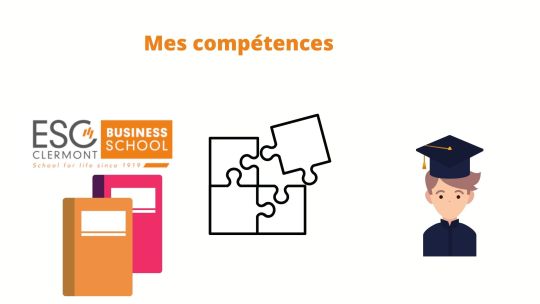
d. Pour chaque expérience professionnelle réalisée pendant le parcours :
Stage des admissibles :
- Ma mission :
Lors des admissibles j’étais dans le pôle commercial. J’étais chargé de trouver des partenariats afin de pouvoir accueillir les étudiants qui venaient passer les concours pour entrer à l’ESC Clermont.
Par la suite, il y a eu le confinement. Notre travail a changé. Nous devions conseiller les élèves à travers un forum et du phoning afin de leur donner envie de venir à l’ESC.
Nous avons aussi beaucoup travaillé sur la communication en tournant des vidéos et en faisant des lives sur instagram et facebook.
Tout au long on a dû promouvoir le programme. Pour que tout ce passe dans le respect nous avons aussi mis en place une charte.
- Contexte de ma mission :
J’ai travaillé dans l’école de commerce ESC Clermont Business school. La culture de l’entreprise est la proximité ainsi que l’esprit de famille. La taille humaine est mise en avant dans nos actions.
L’école se situe 4 boulevard Trudaine 63000 Clermont Ferrand.
Ce qui m’a plus
- Relationnel
- Le contact entreprise
- Le travail sur les réseaux sociaux
Ce qui m’a déplus
- Le fait de ne pas avoir eu l’esprit d’équipe qu’on aurait dû avoir si nous n’avions pas eu le confinement
Ce que j’ai acquis :
Savoir (je connais)
- La méthodologie du feedback
- La méthodologie Tech gestion de projet
- La méthodologie de l’encrage
- La méthode de vente des 6C
Savoir-faire (je sais)
- M’adapter
- Utiliser One drive
- Utiliser le salon virtuel
- Utiliser Teams
- Travailler en groupe
- Faire des affiches
- Communiquer sur les réseaux sociaux
- Réaliser du street marketing
- Réaliser du phoning
Savoir-être (je suis)
- Responsable
- Respectueuse des règles
- Dynamique
- Déterminer
- Ecoute
- Compréhensive
Ce qui est important :
Une des choses importantes dans mon stage des admissibles c’est l’adaptabilité qu’on a dût avoir. En effet avec le COVID19, tous nos projets qu’on avait mis en place ont dû être annulé. A distance nous avons dû remettre en place un nouveau plan d’action sans changer nos objectifs. Nos objectifs qui étaient :
- Remplir les places des filières de master grande école
- Accueillir les étudiants
- Répondre à leur question
- Être numéro 1 dans le classement majeur prépa
- Leur faire aimer la ville
Tout cela en distanciel.
Réalité du poste visé :
Avec ce stage, le métier est un métier de promoteur ou de commercial. En effet dans ce métier, nous devons nous déplacer, expliquer et donner envie aux personnes de venir en l’occurrence acheter notre programme en se différenciant des concurrents. Organiser ces déplacements.
Réalité du secteur :
Le métier de commercial se situe dans un secteur indispensable dans chaque entreprise. En effet, ce métier a pour but de lier les clients à l’entreprise. Leur but est de développer leurs clientèles en augmentant le chiffre d’affaire.
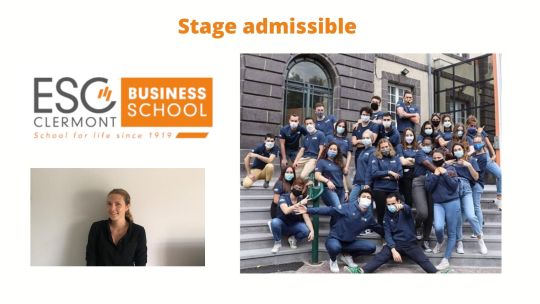
Stage au Palais des thés :
- Ma mission :
Lors de mon stage chez Palais des thés j’ai dû mettre en place le DUERP. C’est un document obligatoire qui doit s’adapter à chaque boutique. Je l’ai adapté pour 5 boutiques (Montpellier, Nîmes, Clermont Ferrand, Avignon, Béziers). Puis j’ai aussi créé un livret d’accueil qui sera donné à chaque nouvel entrant dans une des cinq boutiques. En plus de ça, j’ai dû réaliser des ventes : ces ventes sont des ventes assistées avec une forte connaissance produit.
- Contexte de ma mission :
J’ai réalisé ces missions dans la boutique de Clermont Ferrand : 21 rue des gras 63000.
- Avis :
Ce qui m’a plus
- Le fait de devoir faire les réunions par skype
Ce qui m’a déplus
- Le fait que ces documents doivent être adapté à chaque boutique
- Travailler en équipe
Ce que j’ai acquis :
Savoir (je connais)
- Les règles de mise en place d’un DUERP
Savoir-faire (je sais)
- Reconnaitre les différents types de thés
- Reconnaitre les thés d’exceptions
- Recevoir et conseiller un client
- Animer une réunion
- Préparer une réunion
Savoir-être (je suis)
- Curieuse
- Prise d’initiative
Ce qui est important :
C’est la mise en place du DUERP qui est un document indispensable dans une entreprise. Le DUERP est le Document Unique d’Évaluation des Risques Professionnels. Ce document doit recenser les risques auxquels le personnel peut être confronté. L’écoute des besoins des salariés et la mise en place des actions à mener sont primordiales.
La création du livret d’accueil a permis d’accueillir et d’intégrer un nouveau salarié dans des bonnes conditions.
Réalité du poste visé :
Avec ces missions, le métier visé est un métier de responsable des ressources humaines. Il contribue au bien être des salariés.
Réalité du secteur :
Dans chaque entreprise, au siège social un service RH est présent. Les méthodes utilisées sont en constante évolution. Il est important de se tenir au courant de chaque nouvelle technique.
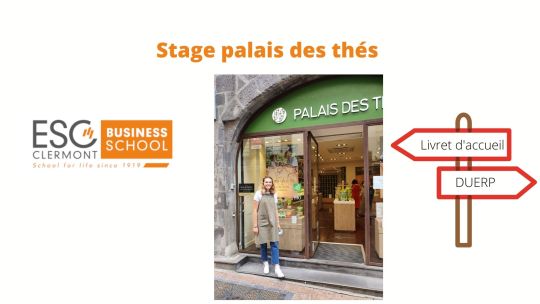
4. Quel métier vise-je ?
a. Mon réseau
LINKEDIN: https://www.linkedin.com/in/lou-ana-girard/
b. Mon plan d’action pour atteindre mon objectif professionnel
1.
Directeur de magasin chez Lidl en alternance
2.
Directeur de magasin chez Lidl
3.
Responsable vente secteur chez Lidl
4.
Directeur des ventes chez Lidl
5.
Responsable des ventes régionales chez Lidl
6.
Responsable des approvisionnements chez Lidl
7.
Création d’une entreprise
8.
Développement de mon entreprise
Je commence par l’étape 1 et mon objectif final est l’étape 8.
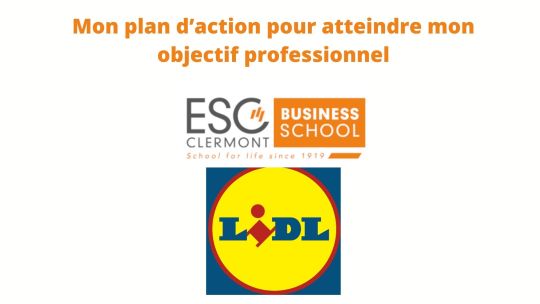
1 note
·
View note
Text
I was tagged by @shine-reblogs so, yeah, why not :3
Rules: Answer 17 questions and tag 17 people you want to know better [I’m taking this as an advise I’m not gonna quite follow exactly oopsie]
Nickname: I don’t really really have one. I always name myself [insert appropriate adjective or noun for every occasion]Fae on the internet, but other than that... Oh! A couple acquaintances call me Queen of Evil, and my bro in law used to call me the Queen of Wolves for a while. Wait, why am I royalty?
Zodiac Sign: virgo
Height: 152cm (5ft)
Last thing I googled: “kaleidoskop lyrics lacrimosa”
Song stuck in my head: I am currently looking for songs to serve as a soundtrack for a project of mine, so I have like 20 to 50 songs stuck in my head and they play simultaneously or interwoven and I don’t even know which ones they are and I’m going crazy,
Hogwarts House: okay, so Pottermore insists on putting me in Slytherin. But, come on! I am not ambitious, or cunning or whatever! You may argue, “but, Fae, you dumbass, you just said people call you Queen of Evil, of course you were put in the evil people’s house!”. And, while you may (or may not) have a point, the rules say Slytherin is for cunning ambitious people, which I am not. Do you know what I am? A nerd. I love languages, I enjoy translating, correcting texts, analysing stories, writing,creating settings for photo shoots, modelling, acting... I enjoy art and being creative. So, shut up, Pottermore, I am a Ravenclaw, fanmade tests confirm it, and common sense confirms it! *puts on her Slytherin scarf with a look of pride on her eyes* What? Yeah, okay, maybe I do enjoy the green and silver, and the ominous setting, and being in the side of villainy. So, let’s say I am a Ravenrin? Slythclaw? Hmm, Ravenrin kinda sounds like a German profession. You have die Lehrerin, die Sängerin, and die Ravenrin. I’m gonna show myself out already. Please, don’t call the cops on me.
Following and followers: I am following 82 blogs and being followed by 15.
Amount I sleep: *nervous laughter* *uneasy laughter* *hysterical laughter*
(Lately, it goes anywhere between 0 and 5 hours).
Dream Job: actress and maybe (alternative) model. Actually, I’d enjoy almost anything which meant performing.
Lucky Numbers: I don’t have such thing as a lucky number. I do like 3, 9, and 22, but I will take any other number as ‘mine’ if it feels significant in a given moment for a given situation.
Wearing: grey leggings, dark grey t-shirt, grey stripped socks, and dark purple housecoat.
Favorite Instrument: the backpipes!
Random Fact about me: I kinda hoard nail polish. I have even a yellow one, and I don’t really like yellow.
Favorite Author: I don’t have one, but let’s say it’s N. K. Jemisin, since the books I read were so beautiful, the characters so aafdghfjhj and I am pretty sure I am gonna lke the rest of her books when I get my claws to them, judging by what I’ve read about them and what I know about the author and how she works..
Favorite Animal Noises: when cats do that cute little meowww calling their human, maybe? I had never thought about animal noises separated from their animals, honestly xD
Aesthetic: neutral colors, mostly dark, tight elastic pants, comfortable. From time to time I’ll feel like suiting up and switch to slutty wanna-be-badass metalhead.
Tagging: there’s no way I’m tagging 17 people, it would be kinda rude to tag someone who doesn’t even know who I am xD Instead I’m gonna just tag my mutuals, I know we don’t talk or anything, so it still feels kinda rude to drag you guys to a game, so please just ignore if you don’t feel like playing. @adorablegorilla @littleerror101
Similarly, if you just happen to see this post and feel like playing, just go ahead and blame me :P
2 notes
·
View notes
Text
Manifesto for Concrete Poetry (1952-55)
By Öyvind Fahlström, Sweden
1. Starting Point
The literary fashion for 1953 was dictated by Sigtuna [where a literary conference was held]. One rejected the psychoanalytically marked bust line and hop line, pulled down the skirt length and lowered the neck line. Since fantasy is to be stressed this year, flounces and butterflies in the hair, everyone Sings with Setterlind (Swedish "court" poet).
All this is well-known. But what lies behind these general recommendations, how shall we realize them? It has been said that we should interpret modern myths (at the same time that Freud has been accused of myth-making); and that we should not bury ourselves in the situation of our time, but should concern ourselves with timeless symbols.
Myths: does this mean to construct a complicated apparatus of symbolic and mythological contacts a la Joyce, Gösta Oswald [Swedish novelist], etc. "who did the same thing with Shakespeare or Virgil"?
Or to give up the precise complexion and to be satisfied with single ideas, most often only single words, floating around without definite contexts? The risk is that the impression will be less timeless and less related to our timeless humanity, quite simply that it will be looser and more general; since the eternally valid word-symbols (if there are such animals) have become faded by much rubbing on the washboard. To some, Lorca, for example, they have been quite useful in new contexts. Also for the surrealists, but on another level, for them it has been valid not to create eternal myths, but myths useful for the future.
At Sigtuna they also talked about the structural analysis of the new criticism. But no one claimed freedom from preoccupation with the self in connection with the claim of interest in poetical structure.
Poetry can be not only analysed but also created as structure. Not only as structure emphasizing the expression of idea content but also as concrete structure. Say good-bye to all kinds of arranged or unarranged private, psychological, contemporary, cultural or universal problematics. It is certain that words are symbols, but there is no reason why poetry couldn't be experienced and created on the basis of language as concrete material.
That the word has symbol value is no more remarkable than that in art representative forms have symbol value over and above their Superficial representational value, and that non-figurative forms, even if it is the white square on the white tablecloth, also have symbolic value and further suggest associations over and above the experience of the play of proportions.
The Situation: since the war a long beer housesad-doomsday-mood, the feeling that all the experimental extremes have been arrived at. For the person who refuses to soar in the worlds of vodka and ambrosia, it remains only to analyze
analyze
analyze the misery with the given means.
Today when the rough symbolic cryptogram, "beautiful" romantic jargon, or desperate grimaces outside the church gate appear to be the current alternatives, the concrete alternative must also be presented.
Starting Point: Everything that can be expressed with language and every linguistic expression on an equal basis with another in a given context that heightens its value.
Therefore Dostoyevsky problematics do not appear to me as anything more essential and human than to consider whether the voices of men are more beautiful in värder [host] or in världar [worlds-pronounced the same as värder]. Motive for drama can be for the poet, as well as for the dictator situated in time, the fixed fact that a certain sound can never be repeated. Experimental psychological results can be taken as starting points for a novel as well as for psychoanalysis. I describe certain people: Bobb, Torsten, Sten, Minna, Pi, without the slightest interest in them as people. Literature won't be inhuman for all that. Ants should only write books about ants, but man, who has the ability to look around himself and objectify, need not be that one-sided.
2. Material and Means
What is going to happen to the new material? It can be shaken up as you like, and after that it is always unassailable from the "concrete" point of view?
This can always be said at the beginning. But the circumstance that the new means of expression have not found their norms of value ready-made, does not prevent us from testing them, if their value is ever to be clarified.
One way is that as often as possible we must break against the path of least resistance, Mimömolan [minsta mötstånders lag]. This is no guarantee for success, but it is a way to avoid sitting in the same spot. To use the system as well as automatism, mostly to use them in combination, but not in such a way that the system becomes other than an auxiliary means. So no ambition whatsoever to reach the purest "poetry" with automatism; even the surrealists do not pay homage to that any more. But do not criticise the systems: if you choose them yourselves and do not follow the rules. Therefore the question is not whether or not the system is in itself The Only Right One. It will become so because you have chosen it and if it gives you a good result.
In that case I can construct, I say construct, for example, a series of 12 vowels in a certain succession and make tables accordingly, even though a twelve vowel series as such does not make the same sense as the series of the twelve-tone chromatic- scale.
It is said that our time longs for stable norms. It is clear: when we tire of regular meter and at last tire also of rhyme, we must find something else that will give the poem that general effect. Nowadays the connecting element has a tendency to be content, both descriptive and ideational content. But it is best if form and content are one.
It remains, therefore, to give form its own norms again. This is already being done in punktmusik. The possibilities are uncountable. In the case of poetry strophes can be broken up into vertical parallelisms in such a way that content determines form by placing the word exactly below the word above it, which it repeats, or vice versa so that when you have a fragment of line vertically parallel with the one above, it brings with it the content of the line above. Identical strophes aided by filling out a line with rhyme on the last word in the line, or with agreed syllables, words, etc. Marginal strophes beside the principal strophes. Framed-form strophes with a kernel strophe within: the possibility for more readings corresponding to the free movement of sight when you look at abstract art. Thus the strophes can be read not only from left to right and from above to below but vice versa and vertically: all the first words in every line, then all the second, the third, etc. Mirroring, diagonal reading. Change of lines, particularly of short lines. Free emphasis and free word order as in classical literature (that we don't have the same linguistic conditions is no reason not to make these experiments).
Therefore a richness of possibilities for reaching greater complexity and functional differentiation so that the different elements of content in a work of art can assume their own shape.
The simplest of all systematizations of formless material is, as always, the change between the contrasts, the contrasts within all thinkable aspects of the work of art. The play between difficult and easy sentences (respectively texts or words), rich and poor, normally syntactic and primitively added, such with and such without context in the environment, lofty, porridgy, knotty, gliding, sounding, and representing.
Not only simple changes but also augmentations -and rhythms. Everything except the lazy stumbling forward according to Mimömolan [the law of least resistance]. (It is something else, of course, if amorphous pieces are put in with intended, directed effect.)
Above all I think that the rhythmic aspect contains unimagined possibilities. Not only in music is rhythm the most elementary, directly physically grasping means for effect; which is the joy of recognizing something known before, the importance of repeating; which has a connection with the pulsation of breathing, the blood, ejaculation. It is wrong that jazz bands have the monopoly of giving collective rhythmic ecstasy. The drama and poetry can also give it. Even in art with its limited time dimension it can be done, Capogrossi has shown that.
It is only to break loose from the grinding of the new, new, new; not to leave behind oneself a kitchen mess of ideas for every step in the work one takes: instead of biting oneself to stick with the motifs, to let them repeat themselves and form new rhythms; for example one works at filling out rhythmic words as a background for principle meanings, which can be bound or unbound by the background rhythm. Independent onomatopoetic rhythmic phrases, like those which the African or East Indian drummer forms to represent his melodies of rhythm. Simultaneous reading and above all-readings of several lines of which at least one has rhythmic words. Of course metrical rhythms also; rhythms of word order, rhythms of space.
Another way to have unit and connection is to widen the logic by forming new agreements and contrasts. The simplest way is to go to the logic of primitive people, children and the mentally ill, the intuitive logic of likeness, of sympathetic magic.
This logic applied to language: - words which sound alike belong together, the fun comes from that. Rhyme has had a similar effect. Myths have been explained like this: when Deukalion and Pyrrha had to create new people after the deluge, they threw stones and people grew up: the name for stone is lias, for people laos.
When the fire has gone out [släckts], I am less sure that it has stopped burning than that the family [släckt] have gone on their way. The fire can both burn and be extinguished [släckt] and be related [släkt] to the family [släkten] or be extinguished [släckt] with the family [släkten]. Laxar [salmon] has to do with laxcring [laxatives], and taxar [dachshund] with taxering [tax assessment], and not vice versa. Homonyms provide great possibilities. Zeugmabinding also belongs here: to connect words, meanings and fragments, for example, poetry is poetry is poetry, where the middle poetry is both end and beginning. And the whole work may be valued for the word put in here and there, always inflexible, a binding cord for structure as realized thought motive. Always the precious repetition for the joy of recognition.
It is valid, particularly in the larger forms, epic,
drama, the film, also, to create happenings of the same
firmness of structure as that of reality. To give the
elements new functions and then certainly, to make
use of them instead of the comfortable improvisations of floating inspiration. To knit the net of relations tightly and clearly. To be bound by conventions you develop yourself but not by those of others.
With such possibilities for richness, ordinary, interpretations and antitheses such as tragically- and comically must be oversimplifications. The whole value in the connection tax-taxering [ dachshund-tax assessment] does not lie in the humorous effect which can result from the unexpected connecting.
Another form of magic with linguistic means is the conventionally seen arbitrary dictation of new meanings for letters, words, sentences or fragments: let us say that in this table all the "I's" represent "sickness," the more "I's" the more difficult-or in this fragment the word "sickness" represents "all sounds, prize stones"-or all words devoid of their own meanings represent "coldness."
You can also go one step in this direction by putting well-known words in such realized strange connections that you undermine the reader's security in the holy context between the word and its meaning and make him feel that conventional meanings are quite as much or quite as little arbitrary as the dictated new meanings. This is no more remarkable than is the case with Povel Ramel Swedish actor: the man who suffered from stage fright among other things and told us that his temperature taken rectally was from the stage of himself [rampen/rumpan], so that-hearing both through the situation and the similarity between the words-we discover a new meaning for the word ramp [stage].
You can't say that the well-known in the strange connection arouses fertile insecurity about the identity between word and apparition in everyone- it may arouse a quite fertile interest in the form itself, if the meanings for the reader are meaningless and he has such a great appetite that lie goes on looking for values. At first many meanings will sound meaningless, particularly amusing or touching, neither forbodingly meaningful nor diffusely sonorous.
Not least because they contain unfairly dealt with words. The unfairly, dealt with words are those which, despite the enormous expansion of the poetic vocabulary during the last century, are not yet considered able to keep themselves dry on the poet's copy sheets. "Salesmen," "excitement," "Clubs," "mine," "horribly," "whisk," "men," "dozen," "glands." These words can, of course, be found, but how often when compared with the old guard. Reading the dictionary is quite as exploratory for the language artist as is turning the pages of a handbook about insects, car motors, or tissues of the body is for the artist.
Meanings can also sound meaningless because they have been constructed in another way. It is valid not only to mix the word order, but to meet the necessities in terms of all the habitual mechanics of sentences or grammatical constructions; and as thinking is dependent upon language, every attack aimed at valid language form will be an enrichment of the worn-out paths of thought, a link in the evolution of language -of thinking, which always occurs on the every day, literary and scientific levels.
Ideas to renew grammatical structures are bound to emerge if you make comparisons with foreign languages, with Chinese, for instance, with its classless words and meaning derived from word order, or with the unexpected and shaded possibilities for expression in the languages of many primitive people. Perhaps it is more important and in any case easier, because of its accessibility, to examine the language of the mentally ill. If, for example, you examine the tests of manic-depressives, you find effects-certainly not meant to be artistic-the connecting of logical resemblances (contaminations), pure soundlikeness associations, modeling with the material of words (neologisms) and more or less rhythmical repetitions (perseverances).
Another way is to see what there is to keep in language found purely mechanically without the use of reading directions or a series system of words and meanings. This will be to break through the frontiers, very slowly to that which means something to you. We can obtain unexpected values from-as we -now see it-the most amputated and kneaded (fragmentized) word elements and phrases.
SQUEEZE the language material: that is what can he titled concrete. Do not squeeze the whole structure only: as soon as possible begin with the smallest elements, letters and words. Throw the letters around as in anagrams. Repeat the letters in words; lard with foreign words, gä-elva-rna [djävlarna = devils]; with foreign letters, ahaanadalaianaga for handling, compare with pig latin and other secret languages; vowel glissandos gäaeiouuåwrna. Of course also "lettered," newly--discovered words. Abbreviations as new word building, exactly as in everyday language, we certainly have Mimömolan [the law of least resistance]. Always it is a question of making new form of the material and not of being formed by it. This fundamental concrete principle can be most beautifully illustrated by Pierre Schaeffer's key experience during his search for concrete music: he had on tapes seconds of locomotive sounds, but he was not satisfied only to connect one sound to another, even if the connection itself was unusual. Instead he extracted a smaIl fragment of the locomotive sound and repeated it with a change of musical pitch; he then went back to the first again and so to the second, etc. so there was a change. He had created a n interference with the material itseIf by means of separation: the elements were not new: the newly-formed context yielded a new material.
From this it will be clear that what I have called literary concretion and non-figurative art is not a style-it is partly a way for the reader to experience word art, primarily poetry-partly for the poet a release, a declaration of the right of all language material and working means. Literature created from this starting point stands neither in oppositional nor parallel relationship to lettrisme or dadaism or surrealism.
Lettrisme: usual "representing" and the "lettristic" words can be experienced as both form and content, "representing" giving a stronger experience of content and a weaker experience of form, "lettristic , vice versa; a difference of degree.
From the standpoint of the result itself, surrealistic poetry can be seen to share certain resemblances with the tables. But there is a difference of starting point which must ultimately influence the results: the concrete reality of my tables does not stand in any kind of opposition to the reality of environment: neither as sublimation of dream or as myth for the future but as an organic part of the reality in which I live with its potentialities for life and evolution.
The coquettish or desperate grimace and even more dadaistic nihilism can be fertile if you see the artistic result, again it is the starting point that separates: I can find no reason to talk about grimace and denial, I have no feeling of fuss, of exceptional condition, that is the normal thing. A constructive dadaism and so none at all.
Having used the word concrete in these contexts, I have related it more to concrete music than to art concretism in its narrow meaning. In addition the concrete working poet is, of course, related to formalities and language-kneaders of all times, the Greeks, Rabelais, Gertrude Stein, Schwitters, Artaud and many others. And he considers as venerated portal figures not only the Owl in Winnie the Pooh but also Carrol's Humpty Dumpty who considers every question a riddle and dictates impenetrable meanings to the words.
Tr. Karen Loevgren, Mary Ellen Solt
From Bord-Dikter 1952-55
top
7 notes
·
View notes
Photo
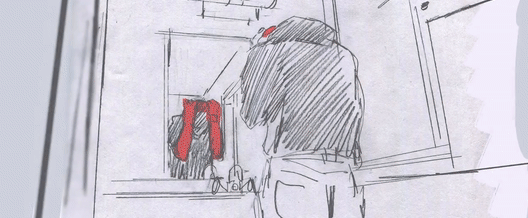



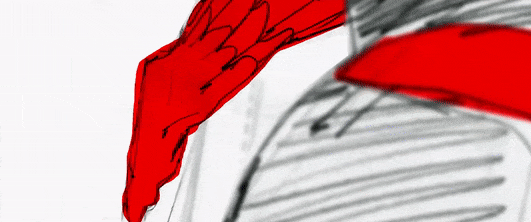



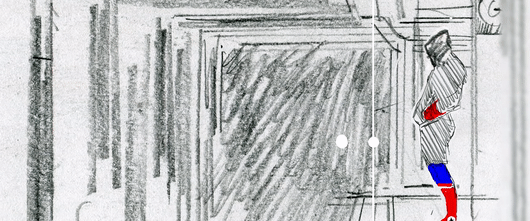

Alberto Mielgo: The Visionary
Spider-Man: Into the Spider-Verse represents a break-through in animated storytelling, pulling compositional and aesthetic inspiration not just from live-action cinema - instead, the artists were inspired by the comic source material adapting dynamic storytelling poses and graphic printing techniques to the animation.
The origins of this style, however, are a little more interesting. As research for this essay, I wanted to take a look behind the scenes and how this new visual language came to be. Looking through the Art of Into the Spider-Verse book, and trawling through countless interviews, online articles and really anything I could find on the process and film itself, it appears that there was a little discrepancy amongst the creators.
The decision to explore such an experimental approach to animation was largely that of the afore-mentioned Alberto Mielgo. A veteran in the animation industry, he strongly believes that the craft has the ability to ‘tell any kind of story’, with a passionate hatred towards mainstream animation. To him, it’s monotonous and mindless work: simply serving to ‘shell Happy Meals’. There’s no real artistic value or risk in these safe, standardized animated pictures, just commercial success: to put it simply, these films make money. Mielgo wants to ‘change the industry’, and with his extensive influence on Spider-Man: Into the Spider-Verse – it seems like he’s sparked the fire, at least.
With a fiery passion for his craft, Mielgo was hired when pre-production began on the film. Tasked with directing the first animation test, in this year and a half, Mielgo and his group of talented animators and CG modellers explored the visual language of the film, delving deep into the mythology of Spider-Man in the process. His task was to explore the language of comics and film, and combine these to produce something the audience had never seen before. His team ended up producing four finished shots, and a series of animatics that ‘open a door to a pipeline and it’s possibilities’.
The shots are intensely cinematic, presenting Mielgo’s vision of a hand-drawn 3D world. Although somewhat rough on movements, these animatics perfectly encapsulate the artist’s initial exploration of the project, and represent a raw vision that the final film has fully realised. With these comparisons, it’s clear to see that these early animatics played a key role in establishing the film’s stylistic visual language and a new, snappy approach to animation. The idea to use comic book panels, illustrated onomatopioa and an experimental approach to composition was the work of Mielgo’s early development in the project, making the conclusion to this story a hard pill to swallow, so to speak.
The artist ultimately found himself with merely a ‘visual consultant’ credit due to creative differences with Sony, it’s clear to see that these early animatics played a key role in establishing the film’s stylistic visual language and a new, snappy approach to animation. According to one of the animators on the film, his animatics were widely seen by the ‘entire animation crew’ before they started working on the film.
With these early tests, Mielgo was able to establish a new production pipeline, and a whole new approach to computer-generated animation. These first tests, whilst being rough in execution, represent Mielgo’s first exploration into this unknown territory, which would later pave the way for artists, modellers and animators who were able to realise this vision in dazzling CG. It would be a disservice to the entire team of animators and visual development artists that worked on the film to simply say it was all the work of Mielgo: big-budget animation, at its heart, is an intensely collaborative industry.
Mielgo created these tests using the Adobe Creative Cloud suite, drawing with pencil and digitally in Photoshop, compositing the sketches in After Effects before editing in Premiere. Comparing these initial animation tests to the final shots demonstrates the team’s real belief in realizing Mielgo’s artistic vision for the film, preserving many of the shots and compositions which has clearly helped to estimate the overall film.
What has changed, however, is the overall atmosphere and mood of the project. Aside from a few notable exceptions, Into the Spider-Verse is a fun, exciting animated feature film. There’s not a great deal of emotional exploration into Miles’ character, who becomes the new Spider-Man in a relatively short period of time. Mielgo’s initial tests, however, present a different film in regard to tone and emotional flavor: these animatics evidence a vastly different creative direction, exploring a more nuanced and personal study of Miles Morales and the emotional burden of living up to the mantle of Spider-Man, the original of whom who found a gruesome demise at the hands of the ‘Green Goblin’.
Interestingly, this version of the film would keep to Peter Parker’s teenage persona as the web-slinging hero – and more explore the idea of the superhero losing the fight. Superhero stories are designed to entertain and inspire us to be better, to find hope in the darkness. This alternative approach to the film, as described by Mielgo, explores what happens is that hero doesn’t save the day, and finds his end at the hands of a truly terrifying supervillain.
To say it was Mielgo’s creative vision wouldn’t be an overstatement: despite his fleeting mention in the credits, it was his cinematic direction, bold and exciting use of vibrant colour and move towards a hybrid approach to animation that defines the look and feel of the final film.
In my previous unit, I put a focus on a more theoretical analysis of a film - looking at large, broader concepts in society. In this essay, I want to put the spotlight back on the actual animation and visual language of the film: how Into the Spider-Verse presents it’s narrative to the audience, in a way never seen before in modern cinema.
With this final research post, I feel like I’m ready to begin work on a first draft on my essay. It’s been a wildly illuminating experience, and I’ve learnt a great deal about the narrative and technical processes used to create my chosen film, Spider-Man: Into the Spider-Verse. Whereas I initially was going to discuss the Hero’s Journey of Miles Morales, through this research process I’ve found the ultimate success and my own interest lies in the visual language and animation of the piece. Instead of analysing the film’s plot, I will be discussing how Into the Spider-Verse presents an entirely new approach to visual storytelling within CG animation - focusing on the animation centric question described in the project brief.
References
Mielgo, A. (2019). Spiderman — +. [online] +. Available at: http://www.albertomielgo.com/spiderman/2018/12/19/d9zh-z04jz8ddc22m0rcduzm56vw4fd [Accessed 1 Feb. 2019].
Mielgo, A. (2019). STORYBOARDS-SPIDERVERSE-ALBERTO MIELGO. [online] Vimeo. Available at: https://vimeo.com/311716775 [Accessed 1 Feb. 2019].
6 notes
·
View notes
Text
Erectile Dysfunction Often Has A Psychological Basis
These relationship problems might be simply avoided if the man was open about his work situation and discussed this with his partner. A GENE which could increase a man’s risk of erectile problems has been identified — raising hope of new treatments. 1.6 billion in 2011, resulting in five-fold increase. 110.45 billion. It operates through two divisions, Human Pharmaceutical Products and Animal Health Products. The present study investigated the effects of two beta(1)-adrenoceptor-selective antagonists, namely nebivolol and metoprolol, on erectile function in hypertensive men. In two meta-analyses, Mouraviev et al. In the new study, among the 873 sexually active men, independent risk factors for ED included Hispanic or other race or ethnicity (except black race), age at the time of the study, and low testosterone levels. Metoprolol may also hide some of the symptoms of hypoglycemia, or low blood sugar. But you should also know what vitamins pump blood flow to where you want it.
This treatment improves blood flow and vascularization which is the primary cause of Erectile Dysfunction and is the only acoustical wave device cleared by the FDA for treatment of ED. Immunotherapy also called as immunologic therapy or biotherapy, is a type of prostate cancer treatment in Kansas City that uses the body’s immune system to facilitate the killing of cancer cells. This incredibly simple therapy was found to cut the number of spreading cancer cells by more 90 per cent in lab mice. Patent expiry of number of blockbuster drugs, canadian prescriptions online availability of counterfeit drugs and increasing manufactures of generic drugs in the market may result in the decline of erectile dysfunction drugs market. The drug ingredients in some ED supplements may interact with prescription drugs in harmful ways. Medications intended for the treatment of cancer is among the medications that can cause Polyneuritis aside from other drugs such as sulfonamides, phenytoin, isoniazid, cytarabine, Ethambutol and others.
Muscle wasting is also exhibited in Polyneuritis and is characterized by thin and weak muscles. He bikes almost every day, but he is starting to complain that his leg muscles are becoming weaker. What they fail to know is that, erectile dysfunction can be just the starting point of some bigger health issues like cardiovascular problem. Teva pharmaceuticals tried to market a generic Viagra (sildenafil) starting March 2012 when Pfizer’s patent was set to run out. Viagra's patent expired in June 2013, allowing GPs to prescribe cheaper generic alternatives. Garlic is the main foods to improve the heart health and also supports to boost the heart function. The IIEF is a self-administered survey with five questions, each scored on a five-point scale and totalled, with lower values representing poorer sexual function. If pain is present use another dose after five minutes or so and repeat twice. That is, what dose offers the best chance at a cure with acceptable toxicity?
Prior to by means of these remedies, it’s always best that you’ve some standard understanding about how these enhancers do the trick. Amantadine is an anti-viral drug that can inhibit the replication of viruses in cells. 60 a pill. And the prices are virtually the same for each brand-name drug. Maca has been extensively tested in rats and shown to enhance sexual desire and performance, and there is ample reason to believe it may have the same effect on the human male. In the case of an erectile dysfunction, there are a variety of vitamins that you need to have proper circulation downstairs. About four percent of men in their 50s experience erectile dysfunction, while nearly half of men older than 75 do, according to the National Institutes of Health. They did not evaluate erectile function, but in primary whole-gland HIFU treatment, about 60% of previously potent men had diminished potency after treatment. Oats contain a rich source of fiber particularly soluble fiber, present.
1 note
·
View note
Note
pls analyse this wand: brick with goblin tooth core
I would have considered this a prank owl if not for the physical evidence that this client presented to me, traces of the brick still on my shaking fingers as I type this.
Additional information given by this shady becloaked witch who certainly hasn’t been loitering outside my door for days:
None.
If I do not publicly analyse this wand, I am a coward, and she will come for me.
A thorough study of goblins’ anatomy is yet to be published in human wizard circles, which is perhaps unsurprising given goblins’ traditional (and justifiable) disinclination to share possible vulnerabilities with humans (though considering the persistent tradition in pureblood households of collecting various preserved goblin appendages, I’d have expected some eccentric bestiary author to take some notes and measurements).
I suspect, however, that this client has some inside knowledge of goblin anatomy. Of course the tooth could have been pilfered from one of the aforementioned pureblood mansions, but I have an inexplicable certainty that this tooth was obtained by fulfilling one of two requirements: first, a rare trust or bargain between goblin and wix; second, an unhappy and specific combination of magical power and amoral cunning not seen in this form since the 16th century in Yardley Platt. The second option is too terrible to consider, so I must congratulate this querent on their enviable connections. (A third option would be that the client was two goblins disguised as one tall witch. Unlikely, since two goblins of average height would produce a 2.4 metre-tall figure, but possible). Therefore her mysterious assertion that the tooth in question is a wisdom tooth bears serious consideration.
Wisdom teeth are so named for their late emergence, but the term dates back at least to the fourth century BC, with a mention in Aristotle’s History of Animals of painful sōphronistêres. The gaining and losing of teeth can be used to mark important milestones in our lives and correspondingly occupy our thoughts, myths and dreams, from Muggles’ milk tooth-offerings for the Tooth Fairy to the iconic post-mortem skeleton’s grin. We seem to have a fairly firm idea of what teeth should be like, and when our expectations are confounded we often respond with horror and fascination, like one might upon being presented in the dim lamplight of one’s porch steps with a brick by a grinning stranger. This is, I would argue, what has made the Tudor propaganda regarding Richard III’s full set of prenatal teeth a subject of such enduring interest.
But what specific significance do teeth have? What particular magical resonance would a goblin wisdom tooth offer? Teeth seem to only occasionally feature specifically in folklore relating to magic, but where they do they are often connected to both bodily and magical power. The common dream of tooth loss is often interpreted as a loss of personal or magical power, or even a warning of death, and some Swedish magic users consider teeth the seat of magical power, with strong or prenatal teeth conferring greater power and lost teeth corresponding directly with lost magical aptitude.
I feel safe guessing that this has the potential to be a powerful amplifier (though more on power and control later), and that more speculatively verbal and close-range magic might be areas to which a goblin tooth wand would be well suited. However, much of the tooth’s power in belief and practice seems to be to do with the link between a person and their own teeth, and as with most materials from sapient creatures individual character has a lot of influence - possibly even more so in the case of a wisdom tooth, taken when the individual’s personality has had time to become realised and settle - so it seems a fair guess that this tooth’s aptitudes will be greatly affected by two things:
the maker and wielder’s relationship to the goblin whose tooth was used;
the goblin themselves, and their particular magical signature and aptitudes.
I can’t help you with these. Ask the goblin.
A brick ‘shell’, while almost certainly not as precise a focus as a more streamlined, pointed traditional wand, will nevertheless provide some measure of control with its geometric shape and precise dimensions. A brick takes the malleable, creative power of clay (in this case enchanted clay, perhaps even from a construct) and makes it solid, dependable, unmoving. However, there’s only so much a single brick can do to control the blunt power of raw magic channelled through a goblin molar. Additionally, a sapient core with a man-made shell is an innovation with implications unknown, though I could hazard some speculations. Focii other than the traditional rod-shaped, usually tapering wand, and other departures from the ‘naturally occurring enchanted wood shell’-‘magical creature/being body part’ tradition, are valid as wand alternatives in principle and in practice, but in this case I doubt this is the continuation of a tradition or the outcome of a sequence of rigorous testing.
In short: this seems like a wand with unforgiving, blunt power, suited to short-range spells without finesse or requirement for adaptation, possibly cast through contact, probably with a shape or pattern to the magic that carries between spells. However, given the lack of research on non-wand focii, the non-traditional materials used and the lack of information on their origins or precise composition, the frankly haphazard construction and the fact that even now I hear her fingers upon the windowpane, I give this analysis with the caveat that this is really outside my realm of expertise. I’m frankly left with more questions than answers. If you’d like clarification on any part of this analysis, do owl, non-threateningly, during normal office hours. I will be strengthening my wards.
N.B. It should be noted that, as part of goblins’ intricate network of debt and belonging beliefs, the tooth in this wand may be game to be reclaimed by the original goblin, or indeed by any goblin. Conversely, the wandmaker’s status as its creator may take precedence, leaving them the right (under some goblin custom) to repossess the wand at any point.
(P.S. I found some cool stuff researching this one, so though I usually try to keep to stuff I can link inline, I figure if you’ve read this far you probably ARE likely to be pretty into teeth and/or folklore. Trollkatt kindly provided sources for the Scandinavian tooth beliefs they posted about (sources in Swedish). Jeri Tanner’s The Teeth In Folklore has a basic but intriguing overview if you’re interested in more Tooth Concepts and want some quick leads to follow, while Of The Teeth focuses specifically on toothache beliefs and The Folklore of Teeth… focuses on milk teeth, with plenty of useful citations. Starkaðr’s Teeth seems a thoroughly wonderful look at a specific Norse hero and his legacy. This cool site introduced me to the term AFOL (Adult Fan Of Lego) and to Tolkien’s dislike for Wagner’s myth retellings. Finally, though by no means trivially, edda-for-dummies is a really cool educational project on the Norse Poetic Edda with rad art and thoughtful writing. Thanks for reading!)
#wand analysis#ic#well#somewhat ic#this is what you signed up for you scurrilous rogue I hope it meets your expectations#goblin tooth#brick#Anonymous#queued post#cephaloblog
37 notes
·
View notes
Text
We are not alright
I get a weekly email from a religious order that I have done volunteer work for in the past. This is a countryside monastery, where the sisters and brothers work together to farm the land, provide for their neighbors, and provide overseas assistance for children of AIDS epidemics, wars, and famines. The emails tend to be gentle musings of the goings on at the farm, history lessons about feast days, and calls for hands to help harvest. Today I got an email that left me speechless. Please read this all the way through, and realize that these words are those of the gentlest monks I know, uninterested in stirring up unnecessary conflict:
Dear Friends,
In recent weeks we have received a very large amount of correspondence. Two questions that continually come up are, what is the moral responsibility of people in these troubled times and what does the rest of the world think about what is going on in the US? We asked some friends in Europe about the latter question. One of them sent us a recent column appearing in The Irish Times. Fintan O’Toole is a respected author and journalist whose writing appears in a number of publications including the New York Review of Books. We have been urged to forward this on to you. It is a disturbing piece but I hope you will read it through and realize this is not a partisan issue but something that concerns all Americans.
Sister Julie
Fintan O'Toole wrote this yesterday in The Irish Times:
“To grasp what is going on in the world right now, we need to reflect on two things. One is that we are in a phase of trial runs. The other is that what is being trialled is fascism – a word that should be used carefully but not shirked when it is so clearly on the horizon. Forget “post-fascist” – what we are living with is pre-fascism.
… (Donald Trump) has an acute understanding of one thing: test marketing. He created himself in the gossip pages of the New York tabloids, where celebrity is manufactured by planting outrageous stories that you can later confirm or deny depending on how they go down. And he recreated himself in reality TV where the storylines can be adjusted according to the ratings. Put something out there, pull it back, adjust, go again.
Fascism doesn’t arise suddenly in an existing democracy. It is not easy to get people to give up their ideas of freedom and civility. You have to do trial runs that, if they are done well, serve two purposes. They get people used to something they may initially recoil from; and they allow you to refine and calibrate. This is what is happening now and we would be fools not to see it.
One of the basic tools of fascism is the rigging of elections – we’ve seen that trialled in the election of Trump, in the Brexit referendum and (less successfully) in the French presidential elections. Another is the generation of tribal identities, the division of society into mutually exclusive polarities.
Fascism does not need a majority – it typically comes to power with about forty percent support and then uses control and intimidation to consolidate that power. So it doesn’t matter if most people hate you, as long as your forty percent is fanatically committed. That’s been tested out too.
And fascism of course needs a propaganda machine so effective that it creates for its followers a universe of “alternative facts” impervious to unwanted realities. Again, the testing for this is very far advanced.
But when you’ve done all this, there is a crucial next step, usually the trickiest of all. You have to undermine moral boundaries, inure people to the acceptance of acts of extreme cruelty. Like hounds, people have to be blooded. They have to be given the taste for savagery.
Fascism does this by building up the sense of threat from a despised out-group. This allows the members of that group to be dehumanised. Once that has been achieved, you can gradually up the ante, working through the stages from breaking windows to extermination.
People have to be given the taste for savagery. Fascism does this by building up the sense of threat from a despised out-group.
It is this next step that is being test-marketed now. It is being done in Italy by the far-right leader and minister for the interior Matteo Salvini. How would it go down if we turn away boatloads of refugees? Let’s do a screening of the rough-cut of registering all the Roma and see what buttons the audience will press. And it has been trialled by Trump: let’s see how my fans feel about crying babies in cages. I wonder how it will go down with Rupert Murdoch.
To see, as most commentary has done, the deliberate traumatisation of migrant children as a “mistake” by Trump is culpable naivety. It is a trial run – and the trial has been a huge success. Trump’s claim last week that immigrants “infest” the US is a test-marketing of whether his fans are ready for the next step-up in language, which is of course “vermin”.
And the generation of images of toddlers being dragged from their parents is a test of whether those words can be turned into sounds and pictures. It was always an experiment – it ended (but only in part) because the results were in.
And the results are quite satisfactory. There is good news on two fronts. First, Rupert Murdoch is happy with it – his Fox News mouthpieces outdid themselves in barbaric crassness: making animal noises at the mention of a Down syndrome child, describing crying children as actors. They went the whole swinish hog: even the brown babies are liars. Those sobs of anguish are typical of the manipulative behaviour of the strangers coming to infest us – should we not fear a race whose very infants can be so devious?
Second, the hardcore fans loved it: Fifty-eight percent of Republicans are in favour of this brutality. Trump’s overall approval ratings are up to 42.5 per cent.
This is greatly encouraging for the pre-fascist agenda. The blooding process has begun within the democratic world. The muscles that the propaganda machines need for defending the indefensible are being toned up. Millions and millions of Europeans and Americans are learning to think the unthinkable.
So what if those black people drown in the sea? So what if those brown toddlers are scarred for life? They have already, in their minds, crossed the boundaries of morality. They are, like Macbeth, “yet but young in deed”. But the tests will be refined, the results analysed, the methods perfected, the messages sharpened. And then the deeds can follow."
Let us protect our freedom with all our democratic power, and continue to be brave with everything we must face.”
1 note
·
View note
Text
A brief discussion on the health benefits of CBD oil.
Nowadays, there is already real hype surrounding hemp oil. Some people do not realize what it is and how it is going to be integrated into daily life. There are numerous myths, considering its increasing popularity. Let us strive to grasp all the problems and figure out what is really true and what is really the fiction.
What is the CBD?
Cannabidiol (CBD) is a substance extracted from cannabis, another ingredient often present in hemp plants, psychoactive effects and otherwise directly responsible too for the particular state of the whole narcotic practical effect. Best Cbd Oil Nz, now on the other hand actually, is not at all a psychoactive substance; it also has many medicinal effects. But there is also an increasing awareness of the whole potential health benefits of such CBD oils.
Actual benefits of using the CDB
As we explicitly mentioned, CBD, unlike with THC, is not really psychoactive. This consistency makes CBD an appealing choice for those needing good pain treatment and recovery from other effects, again without causing harm again to the person’s mental health. It is becoming actually incredibly common in the area of physical health and well-being; several studies affirm its beneficial properties. Here are some of the key advantages of CBD oil that are already confirmed by empirical evidence. Cbd Oil Nz Buy can be easily done.
Managing Pain
Researchers also compiled the findings of numerous systematic analyses spanning hundreds of experiments and tests. Their studies concluded that there is significant evidence that cannabis is a successful cure for chronic pain in adults.
These findings are confirmed by one analysis. This study indicates that the use of CBD can minimize pain and inflammation. Then they also noted that somehow endocannabinoids, such as with CBD, it could be a new therapy for patients with chronic pain. Now there must be a question in your mind that “Can You Buy Cbd Oil in New Zealand?” the answer is yes.
Preclinical studies have shown that CBD decreases pain and inflammation, and tests of CBD in humans and animals indicate that it is well tolerated and has little to no serious adverse effects. Instead a lot of people these days are now all looking to CBD more as an acceptable alternative to pain relief.
Regulation of sleep and fear
However there is real evidence that somehow CBD oil still has a stimulating effect on the central nervous new system. Perhaps the real interest in CBD mostly as a therapy for a wide variety of conditions has grown significantly, but there are still a limited number of clinical trials of CBD even in psychology and psychiatry. Where to Buy Cbd in New Zealand? It is available in most of the places and you would easily find it.
Neuroprotection:
Researchers assume CBD can function as a neuroprotective new compound. It may help minimize damage in the central nervous system and otherwise brain, as well as promote the regeneration and overall growth of further neurons.
Heart Disease
Several heart conditions are some of the most common health issues of our day. They really are the primary cause of death happening. Of note, a balanced lifestyle and follow-up on strict diets are always a top priority right for individuals who are vulnerable to cardiovascular disease, while CBD can also be helpful.
0 notes
Text
IDORU READTHROUGH CHAPTER 1-21 RECAP

Transhumanist rockstar Johnny Silverhand announces his engagement to virtual idol Hatsune Miku, and everyone is upset. A fired data analyst and a teenage Silverhand stan are both sent to Japan to find out why he's gone crazy. Or has he?
I'm joking but that kind of is the story. It's great.
I haven't picked this book up in at least half a year so I can barely remember where I was at (this is more a reflection of myself than of the book). I need this recap for myself, too.
For my previous post on thoughts on the genre, click here.
CONTENTS:
Personal Context
Story So Far
General Thoughts
Predictions
PERSONAL CONTEXT:
When I visited Adelaide in 2019, I found a fairly large second-hand bookstore called O'Connell's Bookshop, which I believe is family-owned. It is super cool, one of those bookstores where the shelves are overflowing and you could probably find somebody's great-grandparents' childhood diary if you looked hard enough. Also, they have a dog! And the dog's name is my name! I'm a bookstore dog! Ahem. I will never not be excited about that. Please visit if you're in Adelaide and say hi to my canine counterpart.
Anyway, I was perusing and randomly spotted a book called Idoru, and my first thought was, "huh this seems like a romanisation of idol in japanese, is this just an old book about japanese idols?" And then I saw William Gibson's name attached to the book called Idoru, and my second thought was "wait, that William Gibson? What has that William Gibson got to do with japanese idols?"
Dumb question, really. The influence of east-asia in general on the development of the cyberpunk genre is huge, so the convergence shouldn't have been surprising. Also, the book's from 1996, so it's relatively recent; I had pigeonholed Gibson to the 80s because I didn't know better, and wondered whether virtual idols were even a thing then.
Either way, the novelty of an intersection between William Gibson and Hatsune Miku was more than compelling enough for me to buy the heck outta that book, and I've been enjoying it.
STORY SO FAR:
Idoru separately follows two protagonists, former data analyst Colin Laney and teenage music fan Chia McKenzie. Both have been sent to Tokyo to figure out what's going on with an old-school rockstar named Lo/Rez, and why he's become engaged to virtual idol Rei Toei.
Colin has just been fired from his job at SlitScan, some kind of pop celebrity dirt-digging company. When his metadata analysis revealed that a teen celebrity was about to commit suicide (after it helped drive her to that point to begin with), he tried to intervene. He failed, a scandal ensued, and he was fired for trying to whistleblow to a media-company-dirt-digging-company. He was dropped when they found out he was once a test subject of a questionable experimental drug, compromising the legitimacy of his story.
Out of job, he's sent to Tokyo to get picked up by Lo/Rez's loyal bodyguard, Keith Blackwell. Blackwell wants to know if his boss has gone off the deep end, and suspects foul play, manipulation or tech-mediated brainwashing. He wants Laney to figure out who's behind it. All Laney can figure out so far, however, is that Lo/Rez leaves astonishingly little metadata to analyse, but has been lying about his activities to Blackwell. Also, Laney's old boss Kathy Torrance wants to blackmail him for dirt on Lo/Rez.
Meanwhile, Chia's VR Lo/Rez fanclub is upset that Lo/Rez has made a marriage announcement, to a virtual idol of all things. The rich one in their group uses her father's credit card to sponsor Chia to go to Tokyo and meet with the fanclub's Tokyo chapter to find out what's up.
On the flight over, Chia unknowingly falls in with some kind of smuggler, Maryalice, who uses her as a patsy to smuggle something into Japan. She takes Chia to her boyfriend's place, where Maryalice and her boyfriend start having a violent argument over Chia's involvement. Chia takes the chance to flee, but unknowingly still has the mysterious smuggled item in her bag.
She meets the Tokyo chapter's representative Mitsuko, who says that nothing is wrong, but Chia is unconvinced. Mitsuko's brother Masahiko takes Chia out to help her investigate, but both their friends warn them they are being stalked by a dangerous unknown group, and the credit card Chia is using is being tracked.
GENERAL THOUGHTS:
Each character in Idoru is described by Gibson with great vividness. They're also colourful to the extent that I feel like I'm experiencing the literary equivalent of the silhouette test for character identity. The descriptions are conveyed with great efficiency. At no point is the story stopping to exposit to you how a character appears, you figure out their appearance alongside their actions and personality as the scene progresses. In that sense, appearance, personality and actions are fused such that the character feels incredibly whole. It's very cool, I wanna emulate that. Also, they'd make great prompts for character design illustration exercises.
Having said that, I feel like this is another story where the supporting cast seem more interesting than the protagonists. Laney is alright; he seems to only be a creased suit-shirt, but at least he's a creased suit-shirt with a backstory. Chia suffers a little though; I can't even remember what she looks like and there wasn't terribly much going on in her life.
I really like Blackwell. Partly for Australian bias, but partly because I think he exemplifies this approach to character writing the best. His image is incredibly solid and unique among the case, he's dripping with personality, and it all works in harmony with every little action we see him take to bring his character to life. He makes a great study for close reading.
There's a very simple and predictable prose structure to the story so far; one chapter of Laney followed by one chapter of Chia, repeat. I'm not really sure how well it works; on the one hand it's nice to know exactly what's coming next, but on the other I feel like it's affecting the pacing a bit in some places. It's hard to end a chapter of Laney thinking, "I want to know what's next," and having to enter a chapter of Chia starting something entirely different.
Sometimes the writing is just unintentionally funny because I live 24 years into the future and japanese culture is now fairly mainstream. "Kelsey drew her nymph-self up with elvin dignity, batting manga-doe eyelashes in disbelief," while referring to a VR anime avatar, just makes me crack up. At the same time, props to Gibson for calling out VRchat anime avvies in 1996.
I'm not sure what's with cyberpunk and automatically taking place in an alternate world history - actually it suddenly made sense to me when I was typing; it's partly alternate to me because I live in the future, and it's partly that their setting is shaped by more extreme fictional, governments, corporations and man-made disasters. Having said, some changes still seem casually random and just thrown in to make the whole world feel different. Australia seems to have had a civil war that created a southern identity, Russia seems to be... fully controlled by the kombinat? Native American countries build laptops. Lots of strange details dotted through the setting.
PREDICTIONS:
None, I'm halfway through the book but I still have no idea what's really going on or what's about to happen. Lo/Rez hasn't shown up yet outside of recordings, and people rarely even mention the idol.
If I had to guess, Chia and Laney's stories seeming to still have nothing to do with each other suggests that whatever connects them has already been revealed. I'd take that to be Chia's accidentally smuggled contraband then, or whatever group is stalking her, though I have no idea what that is yet.
#idoru#bridge trilogy#william gibson#cyberpunk#post cyberpunk#about 1300 words#took about 3 hours though#probably too long#novels
0 notes
Text
Concerns about the echo chamber effect in social media
Social media is increasingly becoming one of sources of politics and news. Nguyen & Vu (2019) believes that although the algorithm of social media allows users to experience personalized customization, in the long run, users will be bound by the circle with the same views as themselves. This because they will inevitably get close to users and content with the same views as themselves, once they encounter the opposite views, they will be unfriended. Therefore, they gradually become separated from the political views and opinions of different values, which forming a polarization.
To be more specific, public opinion kidnapping is one of the harms of echo chamber benefit. Judicial organs are often criticized by public opinion because of some articles with "dazzling" titles, one-sided understanding and emotional feelings. For example, In the case of Chinese actress Tan Songyun, whose mother was killed in a collision on New Year's Day, the culprit was not given a heavy sentence due to negligence, which is far from the public understanding of drunk driving sentencing. In turn, the case raised questions about the "favoritism of public officials," and the public followed seditious and one-sided press reports and began to speculate about money and power dealings between the perpetrators and their families and the judiciary.

(Source of picture from: https://ent.sina.cn/zt_d/tcymm?vt=4&pos=108)
Besides, echo chamber effects lead to views homogeneity and polarization. Some views are repeated on social media, and with no alternative or opposite views, the public has unwittingly engaged in a process of self-brainwashing (Bartlett, 2015). For example, Novel Coronavirus first broke out in Wuhan, Hubei Province, People's Republic of China in late 2019, and then the virus spread to all countries around the world. After the outbreak, the public blamed the virus entirely on Chinese people's preference for eating bats, civets and other wild animals. In fact, in the process of tracing the origin of viruses, all kinds of science and experiments show that novel Coronavirus existed before the outbreak in Wuhan. However, one-sided news has left China's image under the international spotlight plummeting, while its compatriots abroad face discrimination and even threats to their personal safety.

(Source of picture from:https://www.zaobao.com.sg/zfinance/news/story20200124-1023673)
Moreover, in the process of using social media, people tend to trust opinion leaders or friends of non-professional groups around them more than groups with professional knowledge, such as journalists (Keen, 2007). Some people are considered reliable sources of political information (Gold, Katz, Lazarsfeld & Roper, 1956). With human needs and technical support, it is easy for people to get information from the authoritative figures they think, thus reducing the cost of searching for information.
Finally, echo chamber effect can lead to the weakening of the role of opinion leaders. The maturity of algorithm technology and the "information cocoon room" effect make fake news more rampant, making people more willing to believe the first information they are exposed to even if the information can be overturned. A parent in Guangzhou, China, has caused a stir on social media, she lies about a teacher corporal punishment of her daughter on Sina weibo the public accusing the teacher of being unethical. Some medical practitioners have questioned some of the details of parents' claims of corporal punishment, but these rational analyses have not been accepted by the public.

(Source of picture from:http://www.cunman.com/new/82d45999a13b455a99e96262d195f053)
References:
Bartlett, B. (2015). How Fox News Changed American Media and Political Dynamics. SSRN Electronic Journal. doi: 10.2139/ssrn.2604679.
Gold, D., Katz, E., Lazarsfeld, P., & Roper, E. (1956). Personal Influence: The Part Played by People in the Flow of Mass Communications. American Sociological Review, 21(6), 792. doi: 10.2307/2088435.
Keen, A. (2007). The cult of the amateur. New York: Doubleday/Currency.
Nguyen, A., & Vu, H. (2019). Testing popular news discourse on the “echo chamber” effect: Does political polarisation occur among those relying on social media as their primary politics news source?. First Monday. doi: 10.5210/fm.v24i6.9632.
0 notes
Photo




Overview
An intensive and productive week on the course, I wanted to put a focus on the narrative research essay task and balance this academic written nature of the project with the medium of stop motion animation. Additionally, I took the time to develop my skills within Maya: re-attempting the Flying Saucers task at home and playing around with the animation workspace. Whilst I was unable to make any significant progress on my digital metamorphosis project and the animated sketchbook assignment, I instead took the time to undertake extensive research into my chosen film of Into the Spider-Verse, alongside producing a range of stop motion iterations and preparations for the ‘box lift’ task.
As a result, I’ve been able to make a series of stop motion animations that go beyond the limitations of the brief, adding a sense of narrative and interaction between off-screen characters and am confident that I’ll be able to begin work on the first draft of my essay next week. With juggling several projects at a time, as I am now, it’s important to be able to focus on particular assignments. Splitting my time between these briefs has been difficult, but I feel like I’m working to strike a balance between my ambitions for each assignment and the limited time I have left.
Narrative Research
This week, I was able to decide on an analytical direction for my essay and gather a range of research sources in preparation for the drafting process. My initial idea was to analyse the plot of Into the Spider-Verse, exploring how the creators not only presented an updated take on the Hero’s Journey storyline, but also told a refreshing new version of the classic Peter Parker Spider-Man origin story we all know.
Despite this, I realised that the film’s use of this hero narrative is nothing ground-breaking or particularly new. Rather, what makes Into the Spider-Verse rather of academic study is the animation and visual language: an experimental, alternative approach to animated filmmaking, which is already making waves in the industry. Instead of taking a theoretical approach into my chosen film, I began researching into the comic-inspired aesthetic and crisp, stuttery style of CG animation.
The film represents a ‘break-through’ in animated storytelling, pilling compositional and aesthetic inspiration from it’s comic book source material, adapting dynamic storytelling poses and graphic printing techniques to the animation. In my research for this essay, I wanted to take a look behind the scenes and how this new visual language came to be. Looking through the Art of Into the Spider-Verse book, and trawling through countless interviews, online articles and really anything I could find on the process and film itself led me to the work of visionary Alberto Mielgo, the 2012 Disney experiment Paper Man and how the filmmakers created the signature ‘crunchy’ animation style.
Having completed this extensive research into my chosen film, I’ve reached a place where I’m ready to begin the drafting process. With my own question and a range of research sources ranging from the academic literature of Paul Wells to videos breaking down the animation process of Into the Spider-Verse, next week I will begin writing my essay. My aim is to have a completed draft ready for my individual tutorial, in which I will likely be reducing the word count.
Digital Principles
This week, I put a major focus on other projects - taking the time to produce iterations and further develop on the other tasks. As a result, I didn’t really have time to make any significant progress or development in this project.
Stop Motion
This week, we were given our second stop motion exercise: to animate a character lifting up a box. With this task, I’m considering all of the basic principles of animation: specifically timing, anticipation and follow through - additionally to staging the sequence properly.
To begin the week, I took the time to prepare for this week’s stop motion task in a depth I’ve never really done before. Producing my own reference footage and sketching from this has allowed my poses to have an authenticity to them, and I was able to act out a range of characters and situations in the process. Having this additional research and preparation in the filmed reference has given me a solid understanding of the action I will animate.
For my first attempt at this task, I experimented with working from this live-action reference. Whilst this allowed me to see the filmed reference poses directly in Dragon Frame, this method of working also posed several problems - and ultimately resulted in a lacking first iteration. The armature’s movement jolted from one pose to another, the staging of the sequence was ineffective and the timing of the motion was simply wrong.
My main take away from the initial attempt was to consider the posing of my armature more - take the time to make sure the pose is correct, and easily understood by the audience. A second idea was to exercise some restraint on the movement and timing: to take multiple frames with little movement, as stillness can be just as effective as motion. On the flip side of this, I also wanted to explore how to create a fast motion, considering making larger moves between frames to believably communicate a quick movement.
With this in mind, I hired out the Stop Motion Studio in my own time and developed on the task, producing two more attempts. In comparison, these were much more successful and interesting than my first test. Taking the time to develop upon the tasks set in the workshop has allowed me to produce stop motion outcomes of a far higher quality and ambition as it lifts the pressure of time off my shoulders. With my own schedule, I was able to really get lost in the work, and allow me to present a more ambitious attempt at character performance and begin to hint at a narrative beyond simply the action itself.
Next week, we will be exploring a more complex stop motion sequence: having a character walk on screen, and visibly change their expression and emotion. In preparation for this, I will begin recording my own live action reference to get a better understanding of the movements and posing and produce a few storyboard iterations of the sequence.
Animated Sketchbook
This week, I put a major focus on other projects - taking the time to produce iterations and further develop on the other tasks. As a result, I didn’t really have time to make any significant progress or development on this project.
Digital 3D
This week, I took it upon myself to develop upon the previous Flying Saucer task, downloading Maya to use at home and rebuilding the sequence from scratch, using a more planned-out approach. With a humorous direction (the sheep is too heavy for the UFO, which then crashes), I sketched out quick, loose ideas for the sequence. Alongside these preliminary sketches, I also explored Pixar’s approach to the task, Lifted, which also presents a light-hearted take on an alien abduction. With this, I knew I wanted to follow a comical direction that works to effectively subvert the audience’s expectations.
Overall, this represents a far more exciting and successful response to the task. Through iterative development and my own perseverance with Maya, I have been able to challenge myself to create an ‘engaging, successful’ CG animation that puts a new, comic spin on the farm animal abduction’ plot in this short sequence. Something I am going to put a focus on is iterative development on my practical exploration: this was the main point in the feedback of my previous unit, and it’s something I’m constantly considering moving forward. Here, iterations have allowed me to explore and further flesh out this simple CG sequence, and complete an animation (that, whilst simple in composition) demonstrates my new understanding of Maya as an animation and modelling program.
Additionally, we were also set a new task within Maya: taking the focus away from animation, were challenged to explore the modelling potential of the 3D software. Firstly, we were introduced to the Modelling workspace - as we explored the various tools to edit and change an existing shape. This provided us with a range of tools, allowing us to extrude, edit and bevel surfaces of shapes in order to create new, more exciting ones.
Initially, I struggled with this process: but after spending time trying to get to grips with the extrusion tool and asking for feedback, I was able to get a basic understanding of the modelling process and produced a pencil in response. It’s not exactly visually impressive or appealing, but I see the value in this task as a way to introduce the basic foundations of more complex 3D modelling.
The final task was a little more demanding: in the limited time remaining, we were to produce a 3D radio. After experiencing several technical difficulties with the program, I managed to create a basic box-radio following the steps described by our tutor. What I’m finding is the luxury of time with learning these processes: the sessions, whilst helpful, are ultimately too short and fast-paced for me to properly grasp an understanding of the Maya processes. I am somewhat struggling with the modelling side of things, however, I want to develop this understanding and take the opportunity to explore the digital learning world of Linkedin Learning, something our tutor suggested in the session.
In my own time, I managed to complete the radio and add some colour - adding life to the object that I couldn’t really see beforehand. I’m also interested in the potential of rendering this object and seeing how it could move too. Perhaps it squashes and stretches whilst listening to music? It’s a small motion, but I feel like it would be a good independent development of this session and a way for me to add an understanding of the basic principles to my Digital 3D work.
#ba1b:weeklysummary#ba1b:introtostopmotion#ba1b:introto3d#ba1b:narrativetheory#ba1b:animatedsketchbook#ba1b:digitalprinciples
1 note
·
View note
Text
In Vitro Toxicology, Biodetection and Risk Assessment

Opinion
Context
Food may be assumed as a complex mixture of chemicals. Some are intrinsic components, including macro-and micronutrients, anti-nutrients and inherent toxicants, while others are extrinsic, either added or resulting from natural or industrial sources. In addition, process-related chemicals are formed during processing. To understand the health significance of food chemicals is complex. Many increase but others reduce nutritional value. Some may be associated with beneficial effects. A number have been shown to be harmful, producing toxicity. Therefore, chemicals must be managed to ensure that food is safe. Risk assessment, combining exposure and toxicological information, has been valuable to identify chemicals of concern on which management efforts should focus. Toxicological characterization is a resource-intensive and time-consuming process based on feeding experimental animals with high doses of the chemical investigated. Only a limited number of chemicals have been fully tested; for the vast majority of compounds to which humans are exposed, no data is available [1]. This raises the question of how to establish the safety of the numerous toxicologically uncharacterized chemicals.
In vitrotoxicology and hazard characterization
Currently the application of the standard toxicology approach to all known but untested chemicals is increasingly questioned from scientific, feasibility and ethical perspectives. The field of experimental toxicology is currently undergoing a major shift, moving from high dose animal studies towards more mechanistic and human relevant approaches. This is illustrated by large research initiatives such as Tox21, which combines the use of hundreds of in vitro assays with computational modelling [2]. In this framework, the concept of Adverse Outcome Pathways (AOPs) is acknowledged as a way to organize mechanistic information to be applied in risk assessment [3]. In the AOP concept, Molecular Initiating Events (MIE) are linked through pathways/networks of key events to adverse effects. The application of in vitro toxicology in such a context may require the use of human relevant cell systems adequately reflecting organ/tissue diversity and structural complexity together with the application of integrative modelling approaches according to system toxicology [4]. In addition chemical biotransformation must be considered. One of the additional challenges is the suitability of the test systems to cover the most important AOPs. This may be solved through the development of high-throughput toxicogenomic methods. To exploit the data in a context of risk assessment requires translation of in vitro concentrations into in vivo external doses which can be benchmarked against exposure estimates. Currently, methods based on determination of free concentration of the tested chemicals together with physiologically-based biokinetic modelling allow such in vitro to in vivo extrapolations (IVIVE) [2].
Biodetection
The increasing mechanistic understanding of toxic action and its translation into AOPs have triggered the development of cell culture-based systems (bioassays, biotests) to detect bioactivities relevant in term of MIEs and key events. These test systems are not designed to reflect normal human cells/ tissues, but have been constructed to optimize the detection of targeted biological activities (e.g. estrogen receptor activation, DNA-damage) [5,6]. They can be seen as bringing an analytical detection principle that is alternative to the usual physicochemical ones. Application of bioassays to pure chemicals provides insight into their intrinsic biological properties; in chemically uncharacterized mixtures, they highlight the presence of substance(s) associated with a particular activity. Biodetection systems have been successfully applied in many situations, such has for biopharmaceutical quality assurance, for assessment of medical devices and in environmental monitoring, e.g. water. They can significantly contribute to research and development to design intrinsically safe chemicals (green chemistry). They have been recently promoted as playing a potential role in the safety assessment of food packaging materials. The main strength of the application of bioassays is to establish priorities through early identification of chemicals of potential concern. In combination with analytics, relevant chemicals can be identified (effect-directed- analyses). Bioassays may also provide information on potential combined effects of chemicals in mixtures. With regards to risk assessment, bioassay data are rarely usable as such. In general, they must be anchored to more traditional analytical and toxicological information, or to in silico predictions for effective use in this context. For example effect-directed analysis may facilitate the identification and quantification of toxicologically relevant chemicals in a mixture. However, to address their safety significance, exposure must be estimated and compared to toxicological data suitable for hazard characterization [7]. Chemical grouping and read-across are increasingly recognized as an in silico methods to predict toxicological values usable for a risk assessment framework (to establish level of safety concern) [8]. This process consists of identifying analogs of the chemical under investigation (grouping) and extrapolating its toxic properties using toxicological data available for the analogues (read-across). Finding adequate analogs is not straightforward and cannot rely only on structural features. Bioassay data will likely play an increasing role in the definition of chemical analogs. In the case of exposure to a number of structurally similar chemicals, bioassay data may also be valuable to get insight on the need to apply principles of mixture toxicology for assessing risk [9].
Summary and Conclusion
There is a recognized need to characterize the toxicological properties of a high number of chemicals to which humans are exposed. It is increasingly acknowledged that this cannot be achieved by applying a traditional approach based on toxicological studies in experimental animals. In vitro toxicology is thought to be an alternative approach which will play an increasingly important role for hazard characterization and risk assessment, bringing potentially more mechanistic and relevant information for the human situation. In vitro and molecular toxicology have triggered the development of molecular- and cell-based biological tools (biodetectors) designed to detect activities at specific targets. There are numerous potential applications; however, to serve risk assessment, biodetection data should in general be anchored to analytical and toxicological information.
To Know More About Trends in Technical and ScientificResearch Please click on:
https://juniperpublishers.com/ttsr/index.php
To Know More About Open Access Journals Please click on:
https://juniperpublishers.com/index.php
#Juniper publishers#Open access Journals#Peer review journal#Juniper publisher reviews#Juniper publisher journals
0 notes